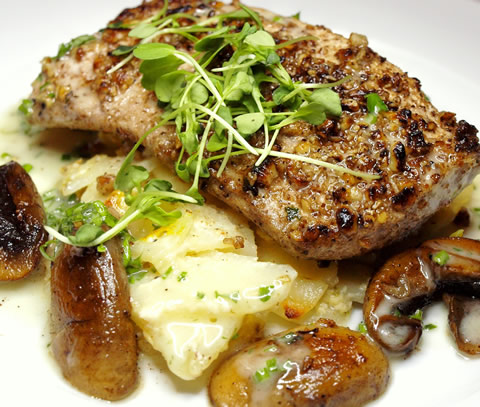 Our annual survey of seafood in Southeast Louisiana this year counts down the 33 best seafood species enjoyed in our restaurants, seafood markets, and homes. For the full survey so far, click here.
Our annual survey of seafood in Southeast Louisiana this year counts down the 33 best seafood species enjoyed in our restaurants, seafood markets, and homes. For the full survey so far, click here.
#24: Mahi-Mahi
Mahi-mahi is the Hawaiian name for a fish found in warm oceans worldwide, including in the Gulf of Mexico. Its other names are dorado and dolphinfish. I think the confusion caused by that latter name is why we use the Hawaiian one instead. Dolphinfish only look like dolphins--the marine mammal with so much brain power that it can train humans to gather around its tank and bring it fish. Dolphinfish, in contrast, are true fish. And a great fish to eat--not only delicious but less prone to overfishing than most fish. Mahi-mahi breed and grow so fast that its populations are stable. (So far, anyway.) My first taste of mahi-mahi came neither in New Orleans nor Hawaii, but in San Francisco. Mason's, a faux-Polynesian restaurant in the Fairmont Hotel, was grilling the fish as early as the 1970s over kiawe wood (Hawaiian mesquite), along with several other Hawaiian fish. It was white with the faintest blush of pink, and had a firm, meaty texture. I thought it one of the best grilled fish I ever ate, and savored it as an exotic experience not likely to be duplicated at home. It wasn't two weeks before I did see it on a New Orleans menu. And it's been around ever since.
Mahi (it's on first-name basis with most waiters and chefs now) is a fine candidate for the grill. You want fillets that are at least three-quarters of an inch thick in the center. I prefer fillets to steaks of this fish, although both are found. It needs little preparation beyond a dusting of Creole seasoning. It benefits from an hour's marination in olive oil, white wine, and lemon juice, to break down its slight chewiness a bit. It also broils to good effect.
The sauce should be something simple, like a beurre blanc or the lighter forms of meuniere sauce. Or a sweet-spicy relish-like salsa, perhaps including fruit.
One of the few problems with mahi is that it needs to be trimmed carefully to remove blood lines and tough parts. It doesn't freeze very well, getting dry in the process. But there's plenty of fresh mahi to be had.
My first taste of mahi-mahi came neither in New Orleans nor Hawaii, but in San Francisco. Mason's, a faux-Polynesian restaurant in the Fairmont Hotel, was grilling the fish as early as the 1970s over kiawe wood (Hawaiian mesquite), along with several other Hawaiian fish. It was white with the faintest blush of pink, and had a firm, meaty texture. I thought it one of the best grilled fish I ever ate, and savored it as an exotic experience not likely to be duplicated at home. It wasn't two weeks before I did see it on a New Orleans menu. And it's been around ever since.
Mahi (it's on first-name basis with most waiters and chefs now) is a fine candidate for the grill. You want fillets that are at least three-quarters of an inch thick in the center. I prefer fillets to steaks of this fish, although both are found. It needs little preparation beyond a dusting of Creole seasoning. It benefits from an hour's marination in olive oil, white wine, and lemon juice, to break down its slight chewiness a bit. It also broils to good effect.
The sauce should be something simple, like a beurre blanc or the lighter forms of meuniere sauce. Or a sweet-spicy relish-like salsa, perhaps including fruit.
One of the few problems with mahi is that it needs to be trimmed carefully to remove blood lines and tough parts. It doesn't freeze very well, getting dry in the process. But there's plenty of fresh mahi to be had.
